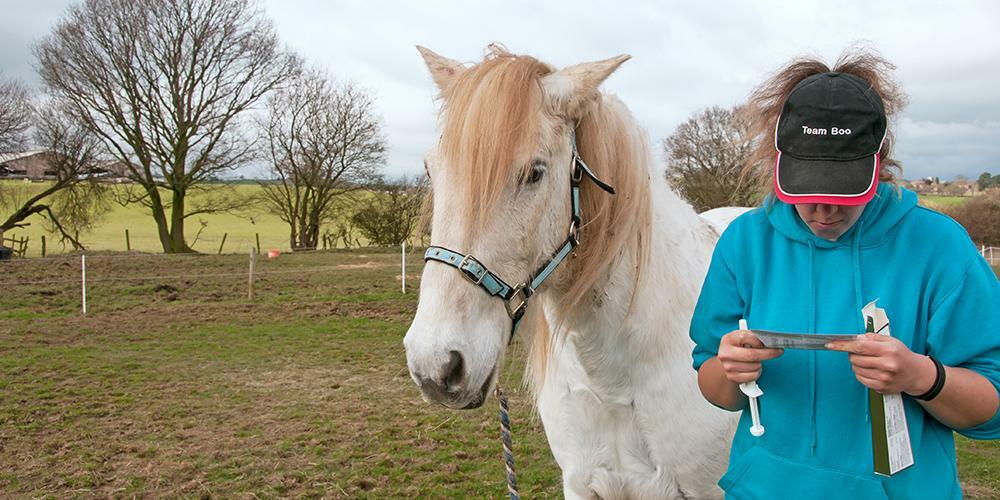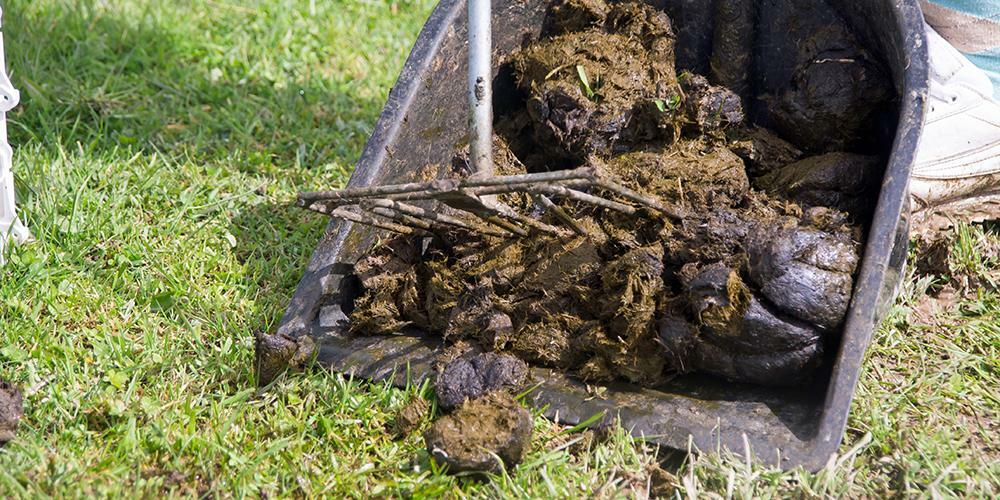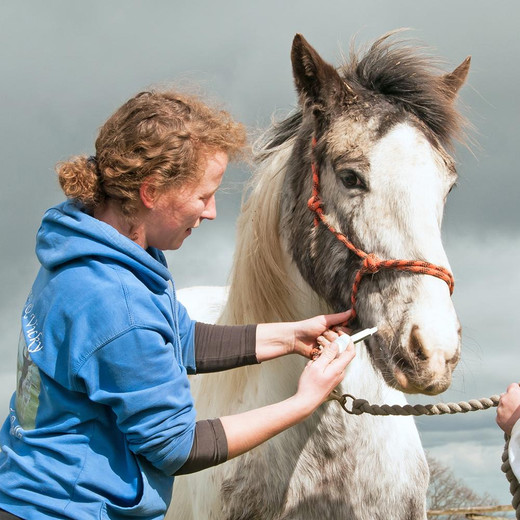A Guide to Worming Horses
Aug 31st 2023
As many horse owners are aware, the management of worms is essential. These parasites can affect the health and well-being of horses and ponies of all ages, so effective worm control will help prevent the worm's full lifecycle and hopefully deter further pasture contamination. Here, we give you a guide to worming, looking at the main types of worms, their effects on your horse and the best times to treat if needed. As every horse is different, you should seek advice and guidance from your vet or AMTRA-qualified SQP (Suitable Qualified Person) regarding the best programme for your horse.
A proper routine to control worms is vital to maintaining a happy and healthy horse. Incorrect parasite control can cause health issues like anaemia, unthriftiness and colic. Over the last few years, we have become more aware that worms are starting to become resistant to the drugs we use to kill them. Therefore, changing how we manage horses to control worm burdens and how we use the deworming drugs is essential. The most effective way to do this is by doing a worm count every 2 – 3 months with a worm count kit. By doing this, you can effectively treat for the correct worm type if needed and help prevent drug resistance.

As there are many types of worms, we’ve made a list below that explores the main species that affect horses and when would be the time to look at treatments. Before you treat your horse, speaking to someone who can offer the correct advice is important.
Small Redworm (Cyathastomes)
When to Treat: Late Winter to Early Spring - December to February.
These are known to be the most common parasites. The Small Redworm has a lifecycle of around a few weeks - from ingesting the larvae to the full-grown adult worm. The larvae develop within the bowel lining and emerge when fully grown. However, some may 'hibernate' in the gut wall (usually called Incysted Red) for some time and can appear in late winter. As well as the ability to cause a great deal of damage to the gut wall, your horse may also display a loss of condition and could suffer from diarrhoea and colic. It may even prove fatal in the worst cases.
Large Redworm (Strongyles Vulgaris)
When to Treat: Summer - March to October.
Before worming regimes became more effective, as they are today, the large redworms were the most harmful parasites to horses. Thankfully, with improved treatments available, the worm is no longer as prevalent as it used to be. The lifecycle starts with the larvae in the bowel, which then migrate to the abdomen and return to the bowel when reaching adulthood. These worms travel through the blood vessels to the artery that supplies the blood to the bowel. This can obstruct the blood supply, damaging the blood vessels and causing blood clots, which lead to severe colic.
Tapeworm (Cestodes)
When to treat: Autumn.
Although these are less invasive than the redworms, they can still cause problems. Tapeworms live in the gut, usually where the small and large intestines meet. Attaching in clusters, they release their eggs to the gut lining. These worms can grow up to 20cm in length and have a width of 1.5cm, which can cause loss of appetite, loss of condition, colic, and, in worst cases, can be fatal. A blood or saliva test can measure your horse's level of antibodies to determine if a treatment is required.
Roundworm (Parascaris Equorum)
When to Treat: Year-round - Worm count every three months.
This type of worm usually affects only young horses, usually foals and yearlings - adult horses will have built up an immunity to them. Roundworms start life in the lungs then migrate to the small intestine, causing your horse to develop a cough. The eggs of the roundworm can live in the dirt for several years, which young horses can ingest while grazing. It will cause unthriftiness, emaciation, dry staring coat, and pot belly. Sometimes, there is an unexplained respiratory illness.
Bots (Gastrophilius Species)
When to Treat: Autumn & Spring
Not strictly worms, but the larvae of the botfly often come under the same grouping as worms. A common nuisance to horses in the summer, the flies lay their eggs on the horse's coat - often around the foreleg and shoulder areas. When the horse licks these areas, the eggs are swallowed. When the eggs reach the stomach, they will hatch, and the larvae eventually pass out in the horse's droppings. It is unusual for bots to cause any medical problems.
Threadworm (Strongyloides Westeri)
Natural resistance to threadworms typically develops by around six months of age and frequently stays dormant in adult horses. These parasites transmit to newborn foals through the mother's milk. Since young foals lack immunity to this parasite, an infection leaves the foal weak and prone to experiencing diarrhoea and anaemia. Additionally, a severe infestation can impede the foal's growth rate. Administering deworming treatment against threadworms to foals as young as four weeks old is recommended, and treating the mare for worms during pregnancy can help diminish the number of worms that transfer to the udder.
Pinworm (Oxyuris Equi)
Although the pinworm doesn't affect the horse's digestive system or cause other internal damage like other worms, they can cause extreme irritation. The female will lay her eggs on the skin around the horse's bottom, but the eggs do not pass through their droppings. Instead, the eggs can dislodge onto bedding and fencing - wherever the horse rubs to relieve the itching. Treatment isn't as straightforward with this worm as the lifecycle is quite different from most others – taking approximately five months to develop and mature (usually around three weeks in others).
Lungworm (Dictyocaulus Arnfieldi)
When to Treat: Treat Donkeys in the spring. Horse owners should seek veterinary advice.
The lungworm is uncommon in horses and usually plays host to donkeys. Donkeys aren't likely to show symptoms of lungworm as they are more tolerant. Horses grazing in the same fields as donkeys may become infected and develop a cough due to the larvae present in the lungs.

Worm Prevention Tips: Manage Your Pasture!
The best thing you can do to help reduce contamination and infection is regularly managing your horse's pasture. Here are some effective methods that are simple to do once you get into a routine:
- Regular Poo Picking: Ideally, you should poo-pick every other day or at least twice a week, reducing the foundation for worm eggs to develop. A metal rake is a great tool to use with your scoop to ensure you gather all manure.
- Don't Overstock: Ideally, you want no more than two horses per acre to reduce the number of droppings in the grazing area, reducing the risk of ingesting worm larvae.
- Don't Use Manure as Fertiliser: Using horse manure to fertilise pastures where horses are likely to graze can increase the risk of spreading parasites.
- Rotation: Ideally, you should rotate your horse between pastures. If you don't have the space, you can section off the grazing area to give your horse fresh grass and allow eggs and larvae to die off.
- Mixed Grazing: Cattle and sheep will happily graze in pastures where eggs and larvae lay as they cannot survive in livestock, so they act as organic hoovers!
If you do have any concerns about your horse's health or well-being, you should contact your vet for advice. For additional information, visit: Westgate Labs.



